The NVIDIA SHIELD Android TV Review: A Premium 4K Set Top Box
by Ganesh T S on May 28, 2015 3:00 PM EST- Posted in
- Media Streamer
- Home Theater
- TV
- 4K
- Shield
- NVIDIA
System Performance
From an editorial perspective, the SHIELD Android TV may be one of the most frustrating devices we’ve worked on in recent history. Simply put, the Android TV market is still a tiny market. Google’s Nexus Player is most of the market right now, and only very recently have other Android TV devices such as the Forge TV and SHIELD Android TV reached the market.
As a result, figuring out what to compare the SHIELD Android TV to and how to present it has been an interesting challenge. A set top box is not a mobile device, and while they share similar OSes and the same families of SoCs, that does not make them identical devices. At the same time however, if we restrict ourselves to just Android TV devices, it would be a very limited and uninteresting comparison. The Nexus Player is a quad-core Intel Atom, but only includes 1GB of RAM, among other limitations.
Ultimately it’s clear that the SHIELD Android TV is heavily overspeced compared to other Android TV devices – no one else is pursuing this premium market – so instead we’re going to focus on looking at benchmarked performance relative to the newest generation of SoCs in the latest iOS and Android tablets. This is by no means a fair matchup and we need to be clear about this – the SHIELD Android TV has no throttling or power constraints, no need to balance out energy efficiency – but it at least gives us some idea of how the device and Tegra X1 compare to other products. Just don’t expect to see a Tegra X1 tablet perform this well. And in the meantime, some of the results may surprise you.
As always for an Android device review, we'll start off with our browser benchmarks. SHIELD Android TV doesn’t actually ship with a browser – we had to sideload Chrome – but these are among our most flexible benchmarks and help put performance in context of more than just Android devices.
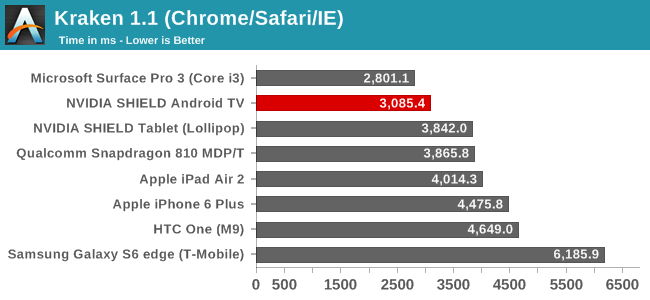
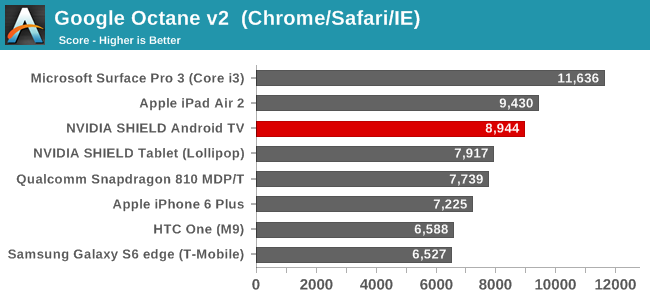
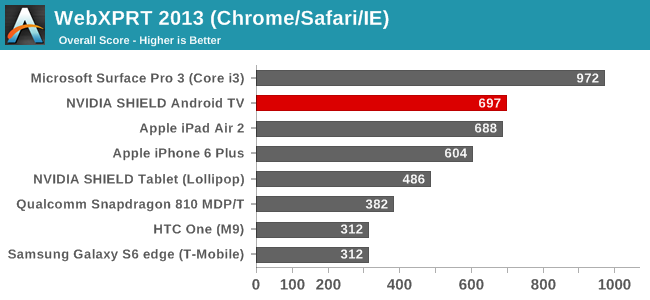
Among Android devices, the SHIELD Android TV stands alone, as you’d expect. Without any throttling to hold it back, it leads over Tegra K1, Snapdragon S810, and Exynos 7420 over all 3 web benchmarks. That said, even with its unrestricted Cortex-A57 CPU cores, we also find that Apple’s A8X-based iPad Air 2 is a close match in Octane and WebXPRT, just edging out the SHIELD Android TV and being edged out respectively. Meanwhile for anyone curious how this compares to high-end x86 tablets like the Surface Pro 3, well even SHIELD Android TV isn’t quite up to par with those devices at this time.
Moving on, we have Basemark OS II 2.0, which should give a better picture of CPU performance in addition to overall device performance.
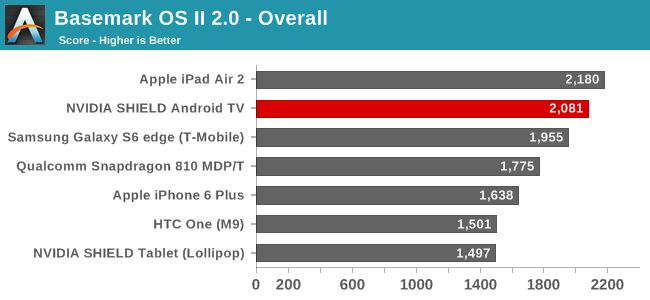

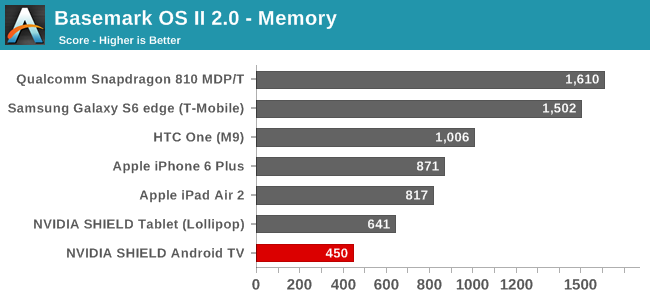
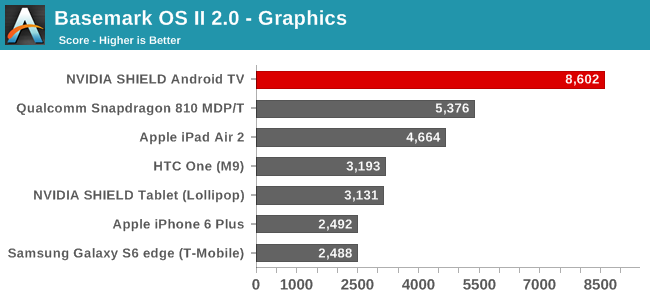
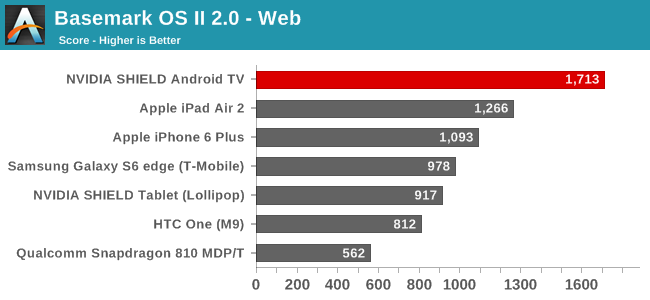
Overall, performance under Basemark still slightly favors the iPad Air 2. SHIELD Android TV easily takes the second spot, but it’s not enough to catch Apple’s tablet.
Looking at the subscores, we can see why this is. SHIELD Android TV only fares decently under the System test, but not well. The big surprise here is not the iPad, which always does well, but the fact that the SHIELD is so far behind the Galaxy S6, which features a similar CPU setup. As this sub-test pushes both the CPU and memory, we may be seeing something related to the implementation differences between Tegra X1 and Exynos 7420, or it may just be an Android TV-inspired difference.
However the memory score is particularly bad, coming in behind even the last-generation SHIELD Tablet. As this is a NAND test, what we're likely seeing is a consequence of the SHIELD's poor random performance, something we'll dive into a bit later in our detailed look at NAND performance.
On the other hand, graphics and web performance are outstanding. We had certainly expected the SHIELD to do well in graphics given what Maxwell is capable of – it is a graphics monster unlike any other current SoC – but the web test is a pleasant surprise. The combination of using Android TV’s built-in web view and the lack of any real throttling likely play a big part here, and although Android TV doesn’t ship with a standard web browser, this bodes well for any apps making use of web view and Javascript.
Our next system benchmark is PCMark, which does a number of basic benchmarks designed to stress various aspects of the device in everyday workloads like video playback, web browsing, text editing, and photo editing. This tends to test every aspect of a mobile device, unlike microbenchmarks that can often miss aspects of the system that can affect performance.
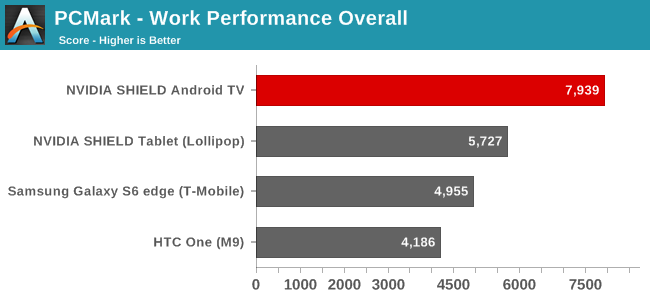
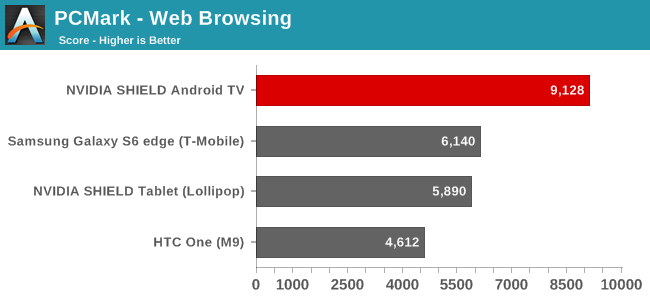

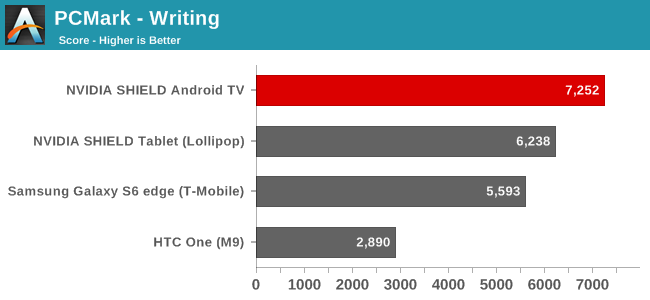
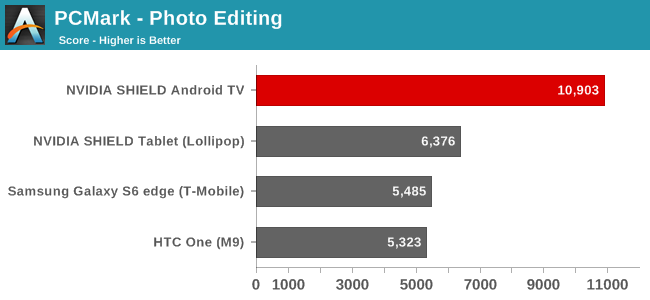
With the exception of the Writing subtest, where the SHIELD Android TV and second-place device are kind of close, PCMark is a runaway victory for the SHIELD Android TV. Once again we’re almost certainly seeing the benefits of the box’s aggressive performance since it doesn’t need to throttle down, or even be conservative on clockspeeds for power purposes. In which case it gives us an interesting look at what Cortex-A57 can do when not held back.
Overall, CPU/system performance is more or less what one would expect based on the design of the SHIELD. As a set top box with a quad-core A57 implementation under the hood and the cooling to let it run wild, SHEILD is frequently A57 at its best. Which means it’s going to easily surpass other A57 devices in most situations, but it also means that even with its unrestricted performance, Apple’s A8X processor and its tri-core “Enhanced Cyclone” CPUs still serve as a reminder of those times where A57 struggles against Enhanced Cyclone’s high-IPC design.
For our final look at system performance, let’s take a quick look at the SHIELD's built-in NAND performance with AndroBench 4.0.
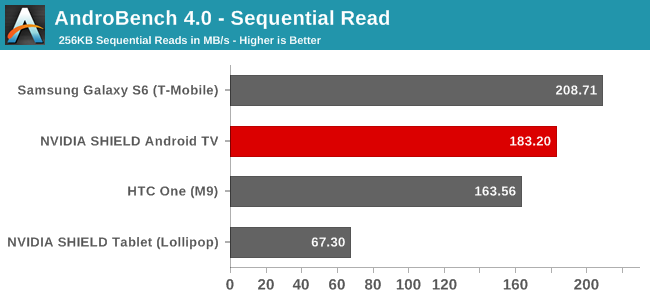
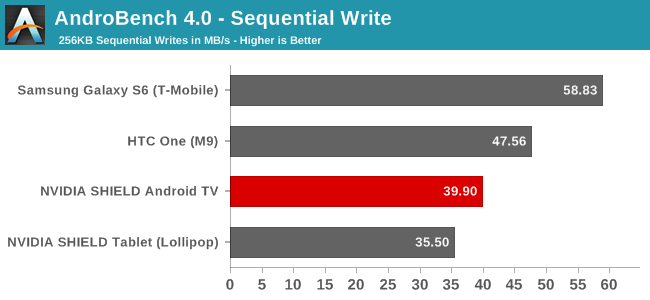
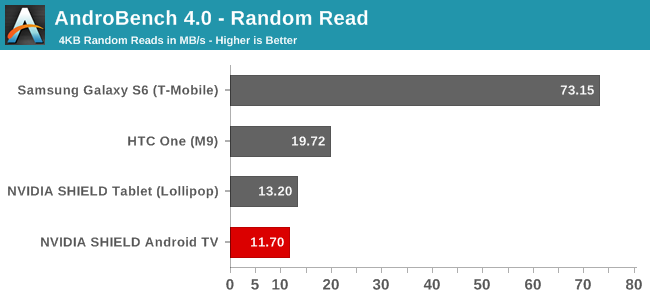
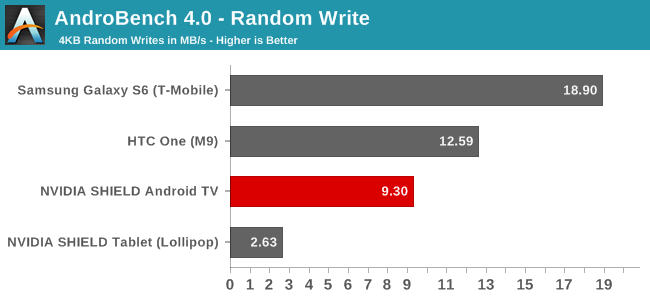
Update 5/28: AndroBench numbers have been revised to account for an error, sorry about that
Though we only have a few AndroBench 4.0 results compiled so far, it’s enough to paint a decent picture. For sequential reads the SHIELD’s built-in NAND fares relatively well. It’s not enough to top the Galaxy S6 and its UFS flash, but it’s keeping up with the pack. Sequential writes on the other hand aren't quite as good, with write performance ahead of only the SHIELD Tablet. Meanwhile random performance is a real mixed bag; the SHIELD Android TV is at the bottom of the random read chart - below even the SHIELD Tablet - while random write performnace is significantly better than the tablet, but still chasing the M9 and well off the S6.
Among Android flagship devices UFS definitely gives the Galaxy a big benefit here, but the SHIELD could stand to improve all the same. However I’m not sure how much that matters to NVIDIA, as the SHIELD is clearly designed to lean on external storage via microSD/USB for users who end up using it for storage-intensive needs such as gaming as opposed to basic set top box streaming.










167 Comments
View All Comments
testbug00 - Friday, May 29, 2015 - link
Nintendo can design a competent OS. The fact their OS runs smoother than Android did for years on Hardware that Android would choke on isn't really a negative.I'm not joking either, the sad part. And, why would the hardware force them to? Why would they risk people being able to pirate all their games super easy?
tipoo - Friday, May 29, 2015 - link
The 3DS, sure, modern android would choke on that hardware. But the design of getting around is still pretty byzantine. Anywho. The Wii U though? With 2GB RAM, half reserved for the OS, and three PowerPC750 based processor cores at 1.2GHz, the thing is still terribly slow for something released so recently. Meanwhile Android is butter with four low power Cortex A7 cores and does ok on 1GB RAM total.Not saying they should or shouldn't. And I'm not sure it would make piracy easier - even going with Android, being open source they can add their old security. Not that the Wii or DS were very secure from piracy either.
tipoo - Friday, May 29, 2015 - link
And what I mean by the 3DS bit...I picked up a 2DS from Target Canada while they were liquidating, half off so I thought what the hell. Didn't have much chance to use it until now.Went into street pass, there was an update available. Ok, go for it. Hit ok, confirm ok, yes it's ok it will take a while. Loads for a minute, then tells me I need to do a system update first. Figure out how to do that, easy enough. Start system update, confirm system update, yes it's fucking ok it will take a while. System update done.
Go back to streetpass plaza, start update. Hit ok, confirm ok, yes it's ok it will take a while. Connecting to online account. Cool. Takes a minute. Then tells me I don't have enough SD storage space. You couldn't check that first?! There's a message that tells me where to go to free storage. So, why can't there just be a button within the message that takes me there?
It could be because every time you close software, there's a button to really close it, and then a confirmation dialogue. Ach, getting real tired of your shit, Nintendo. A few more seconds of wait after you hit the *real* close button, too, because...I dunno. Nintendo.
Delete some crap. Go back to install the thing. Hit ok, confirm ok, yes it's ok it will take a while. Works this time. Go through the new Plaza to see what's new. Go through a bunch of dialogue with a talking rabbit just to see screenshots of each game. You can hold R, but it's still pretty slow.
Did I mention slow? The byzantine software layout may not even bug me as much if the thing was fast, but this is *really* slow. It's old hardware, I get that, plus it was low end hardware even at launch, but that doesn't stop it from being aggravating. The eShop being the worst of it. Going back and forth through pages is painstaking.
Some people have and probably will try to remind me that Nintendo is focused a lot on children. I honestly don't think even kids need all this padding though - this is the iPad generation, they'll get the hang of things in a jiffy, and don't need three confirmations from a talking dildo or whatever weird crap Nintendo wants to do every time they open or close software or after they've already said yes to a download.
Even with more attractive games on it than smartphones have, I find myself almost reluctant to use it every time for the slowness and very pre-iPhone software.
eanazag - Friday, May 29, 2015 - link
Nintendo just needs to give up on the hardware aspect and just distribute software. I would even pay for oldies like Excite Bike on iOS/MS Store/Google Play. I think they can still do regular consoles, but I have been disappointed with them. Good peripherals is still a market they could sell for.If anything, just sell the old stuff on those other services a make a dollar.
mkozakewich - Saturday, May 30, 2015 - link
If I were them, I'd work with a vendor to design a Nintendo Phone. Like, imagine an LG phone with Nintendo branding, a thumbstick, and four buttons? Maybe shoulder buttons, too. Whatever they could fit. (They might be able to get away with shoving all the usual 3DS buttons on.)smorebuds - Tuesday, June 2, 2015 - link
This is more what I was referring too. If Nintendo focused on releasing software (to the Android/iOS market where they'd make the biggest splash) then wouldn't a Nintendo set top box like this Shield make sense too? It would just be the Nintendo-branded and skinned Android box, maybe with some extra Nintendo-specific features thrown in.FMinus - Wednesday, June 3, 2015 - link
Why would they do that, I'm still pretty happy with my WiiU and their hardware offers something that noone else does, or usually copies it in one way or another. Besides Nintendo is sitting on a lot of cash, possibly more as Microsoft and Sony game divisions together anyway, so there's no fear of them going away anytime soon.Aside of that, they are the only company making consoles relatively affordable and kid friendly. Just as an example The Xbox/Playstation UI are an abomination to navigate for a 6 to 10 year old. And most importantly, Nintendo is focusing on games, not being the center of your living room, I'd gladly strip both the Xbox One and Playstation 4 of all the useless features (to me) if they offered them for $250.
stoicromance - Thursday, May 28, 2015 - link
So am I to understand that you can load pretty much any Google Play app onto this? Can I just throw VLC and Plex onto the Shield?Ryan Smith - Thursday, May 28, 2015 - link
Through the Play Store, an app needs to be flagged as supporting the 10ft Android TV UI in order to show up. Though you can sideload practically anything.ganeshts - Thursday, May 28, 2015 - link
Plex already comes pre-bundledVLC doesn't work that well right now on the SHIELD